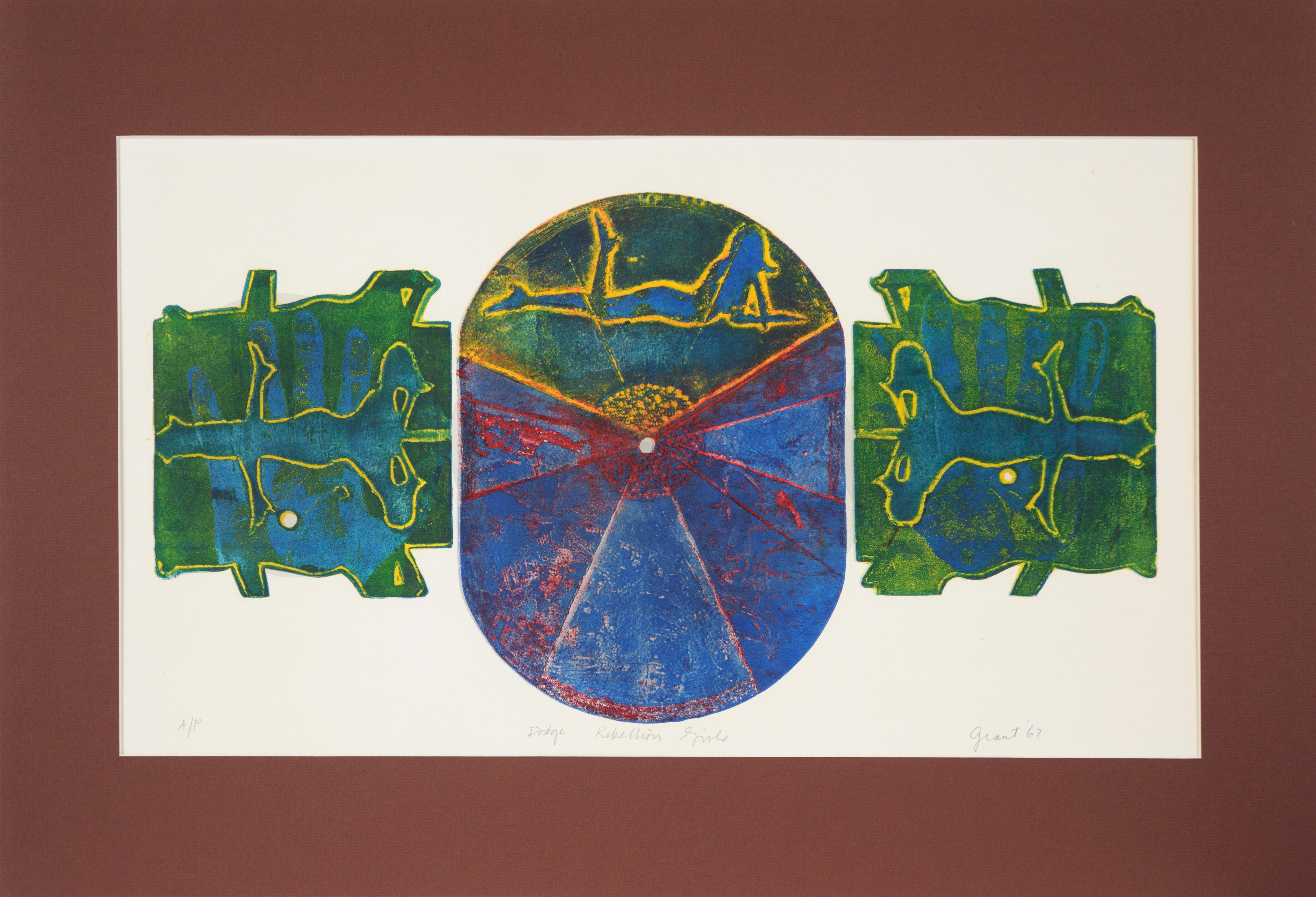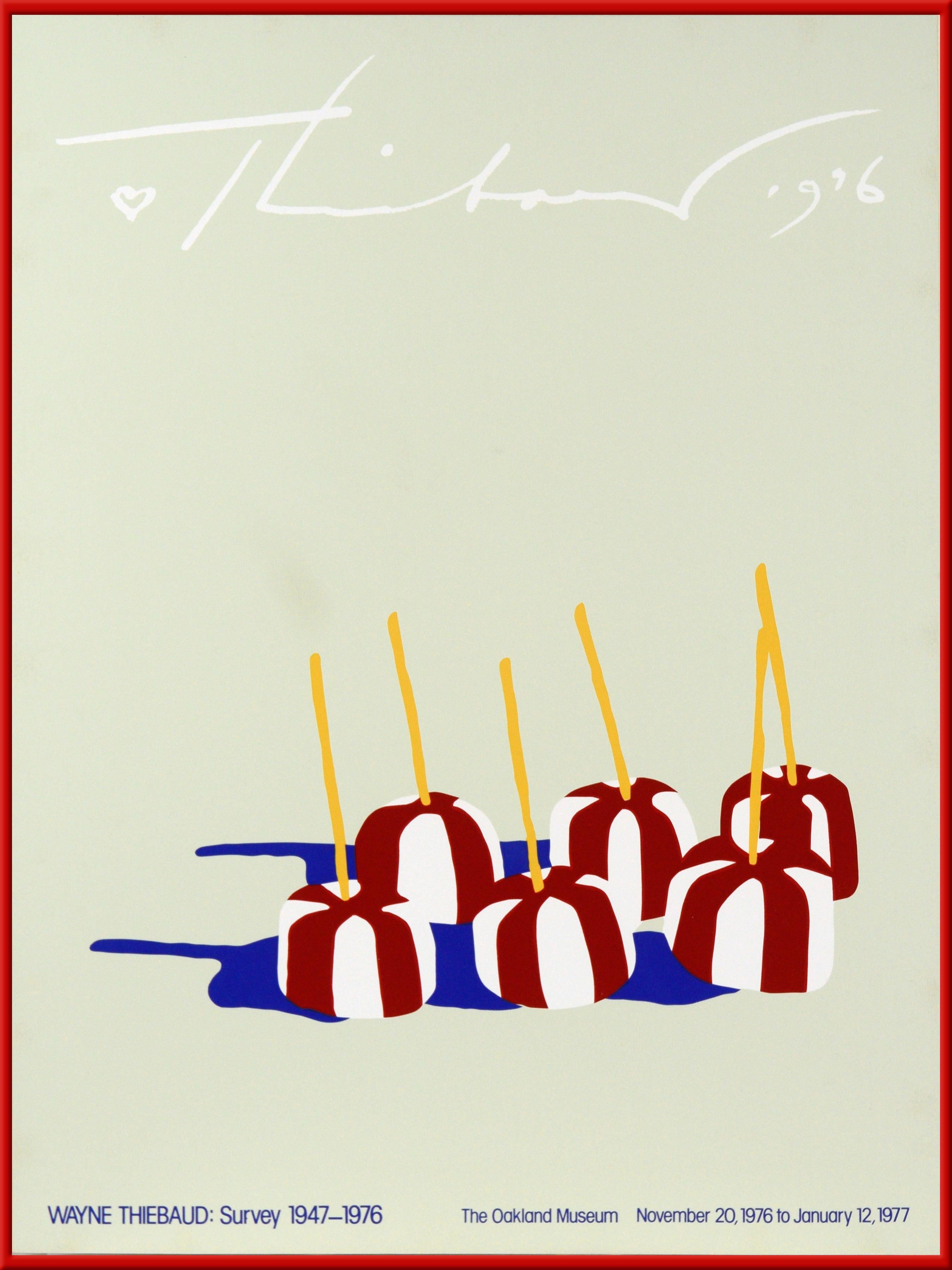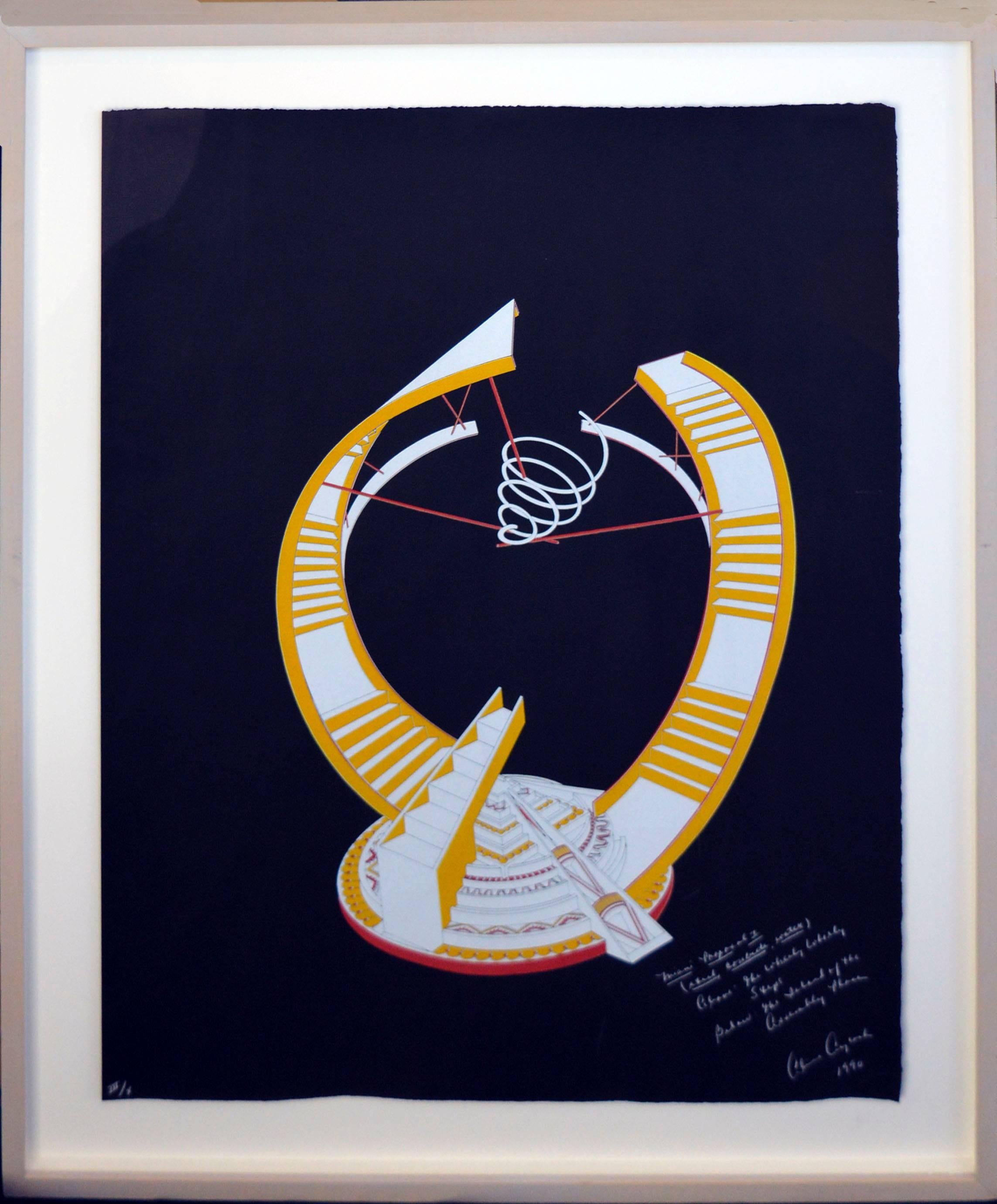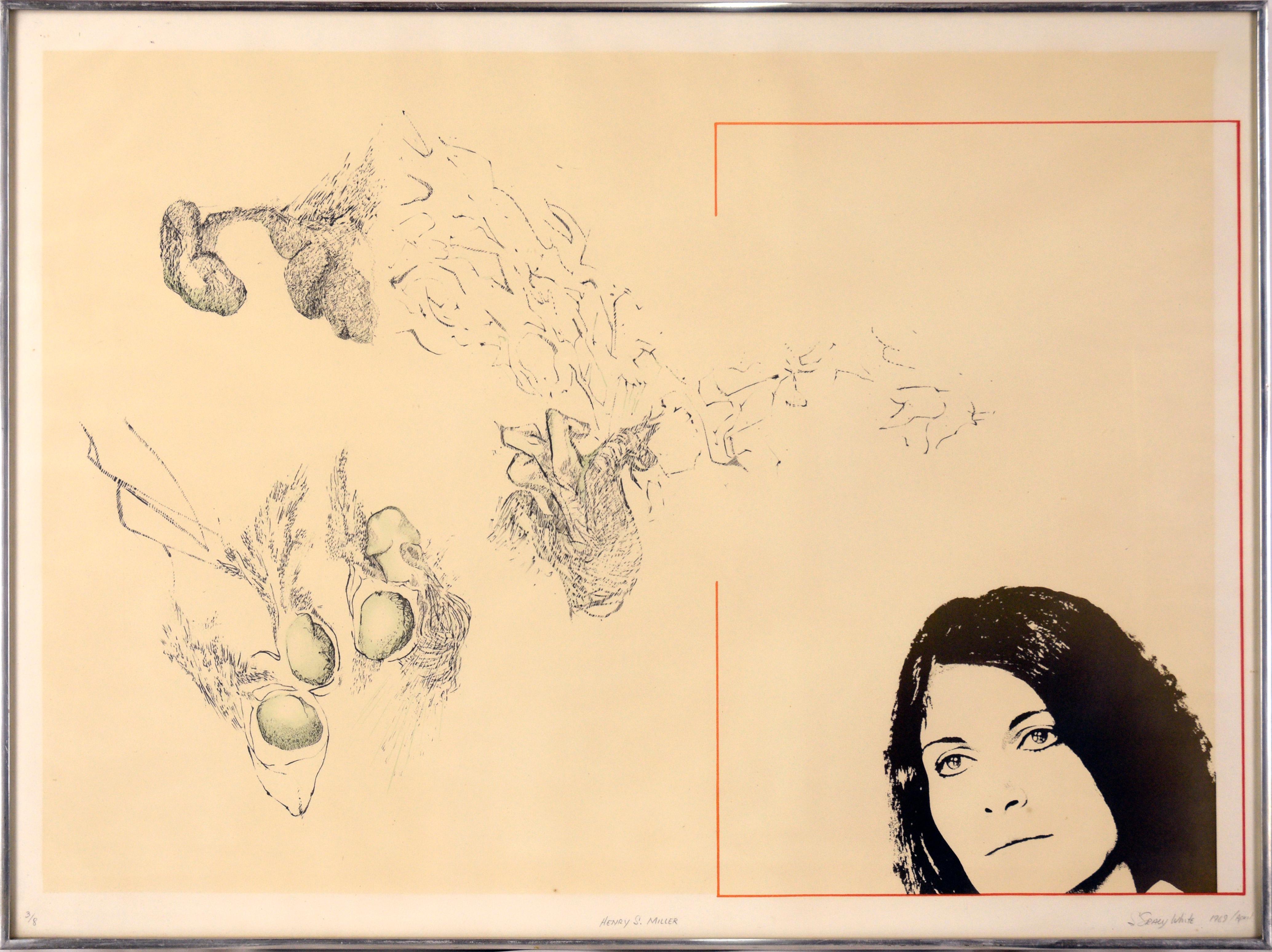Items Similar to "Indianapolis Museum of Art Inaugural Exhibitions", Color Silkscreen, Signed
Want more images or videos?
Request additional images or videos from the seller
1 of 10
Robert Indiana"Indianapolis Museum of Art Inaugural Exhibitions", Color Silkscreen, Signed1970
1970
About the Item
"Indianapolis Museum of Art Inaugural Exhibitions", 25 October 1970, is an eye popping large bold colorful geometric abstract silk screen. It is signed on the lower right.
Robert Indiana, one of the preeminent figures in American art since the 1960s, played a central role in the development of assemblage art, hard-edge painting, Pop art, Neo-Dada, American Modernism and Modern Art. A self-proclaimed “American painter of signs,” Indiana created a highly original body of work that explores American identity, personal history, and the power of abstraction and language, establishing an important legacy that resonates in the work of many contemporary artists such as Andy Warhol, Keith Haring, Roy Lectenstein, David Hockney, Romero Britto, Richard Hamilton and Robert Rauschenberg who make the written word a central element of their oeuvre.
Robert Indiana was born Robert Clark in New Castle, Indiana on September 13, 1928. Adopted as an infant, he spent his childhood moving frequently throughout his namesake state. At 14 he moved to Indianapolis in order to attend Arsenal Technical High School, known for its strong arts curriculum. After graduating he spent three years in the U.S. Air Force and then studied at the Art Institute of Chicago, the Skowhegan School of Sculpture and Painting in Maine, and the Edinburgh College of Art in Scotland.
In 1956, two years after moving to New York, Indiana met Ellsworth Kelly, and upon his recommendation took up residence in Coenties Slip, where a community of artists that would come to include Kelly, Agnes Martin, James Rosenquist, and Jack Youngerman had studios. Indiana, like some of his fellow artists, scavenged the area’s abandoned warehouses for materials, creating sculptural assemblages from old wooden beams, rusted metal wheels, and other remnants of the shipping trade that had thrived in Coenties Slip. The discovery of 19th century brass stencils led to the incorporation of brightly colored numbers and short emotionally charged words onto these sculptures as well as canvases, and became the basis of his new painterly vocabulary.
Although acknowledged as a leader of Pop, Indiana distinguished himself from his Pop peers by addressing important social and political issues and incorporating profound historical and literary references into his works. In 1964 Indiana accepted Philip Johnson’s invitation to design a new work for the New York State Pavilion at the New York World’s Fair, creating a 20-foot EAT sign composed of flashing lights, and collaborated with Andy Warhol on the film Eat, a silent portrait of Indiana eating a mushroom in his Coenties Slip studio.
1966 marked a turning point in Indiana’s career with the success of his LOVE image, which had been featured in a solo exhibition at the Stable Gallery. The word love, a theme central to Indiana’s work, first appeared in the painting 4-Star Love (1961). Love is a subject of great spiritual significance for the artist. Initially experimenting with a composition of stacked letters in a series of 1964 rubbings, Indiana subsequently turned this inventive design, a formal departure from his previous works, into different hard-edged color variations on canvas. Indiana’s LOVE, selected by the Museum of Modern Art in 1965 for its Christmas card, quickly permeated wider popular culture, and was adopted as an emblem of the “Love Generation.” Appearing on a best-selling United States Postal Service stamp (1973) and reproduced on countless unauthorized products, the proliferation of the image led, on one hand, to negative criticism and incorrect assumptions of the artist as a sell-out. However, the image’s popularity more importantly emphasizes its great resonance with large and diverse audiences, and has become an icon of modern art.
In 1978, Indiana chose to remove himself from the New York art world. He settled on the remote island of Vinalhaven in Maine. There Indiana turned to themes that related to his local experience, working on a suite of eighteen large-scale paintings known as The Hartley Elegies (1989-94), inspired by the German Officer paintings of Marsden Hartley, who lived on Vinalhaven in the summer of 1938.
In addition to being a painter and sculptor, Indiana has created a significant number of prints, among them the Numbers Portfolio (1968), a collaboration with the poet Robert Creeley, as well as many other works of graphic art, including the poster for the opening of the New York State Theater, Lincoln Center (1964), the poster for the opening exhibition of the Indianapolis Museum of Art Inaugural Exhibition 1970, as well as the poster for the opening of the Hirshhorn Museum of Art (1974.)
Indiana’s artwork has been featured in numerous solo and group exhibitions around the world, and his works are in the permanent collections of the Museum of Modern Art and the Whitney Museum of American Art in New York, the National Gallery of Art, the Hirshhorn Museum and Sculpture Garden and the Smithsonian Museum of American Art in Washington, D.C., the Albright-Knox Art Gallery in Buffalo, New York, the San Francisco Museum of Modern Art, the Menil Collection in Houston, the Currier Museum of Art, Manchester, New Hampshire, the Museum Ludwig in Cologne, Germany, the Stedelijk Van Abbemuseum in Eindhoven, the Netherlands, the Museum Ludwig in Vienna, Austria, the Art Museum of Ontario in Toronto, and the Israel Museum in Jerusalem.
In 2013 the Whitney Museum of American Art hosted the artist’s first New York retrospective, Robert Indiana: Beyond LOVE, curated by Barbara Haskell. Indiana passed away in his home on May 19th, 2018, just a few weeks before the opening of his sculpture retrospective at the Albright-Knox Art Gallery.
- Creator:Robert Indiana (1928 - 2018, American)
- Creation Year:1970
- Dimensions:Height: 35.5 in (90.17 cm)Width: 25.5 in (64.77 cm)
- Medium:
- Movement & Style:
- Period:
- Condition:
- Gallery Location:Detroit, MI
- Reference Number:1stDibs: LU128617483682
About the Seller
5.0
Gold Seller
These expertly vetted sellers are highly rated and consistently exceed customer expectations.
Established in 2014
1stDibs seller since 2019
95 sales on 1stDibs
Typical response time: 3 hours
- ShippingRetrieving quote...Ships From: Detroit, MI
- Return PolicyA return for this item may be initiated within 14 days of delivery.
More From This SellerView All
- Douglas Semivan Print "Abstract in Gold and Black"By Douglas SemivanLocated in Detroit, MISALE ONE WEEK ONLY "Abstract in Gold and Black" is a well-balanced calm piece. The placement of the gold and white can be read as a distant landscape giving much imagined space to the heavier black area which contains a linear element and the color blue. Semivan is a Master Printmaker and sculptor. He often breaks his surfaces and extends beyond the perimeters in his sculptures. The particular placement of the black area in this piece suggests such a breakage beyond the edge where one imagines a continuation of the strokes or linear elements. This is an altogether extraordinary print. Born in Detroit, Michigan, Douglas Semivan...Category
Late 20th Century American Modern Abstract Prints
MaterialsPaper, Printer's Ink
- Douglas Semivan Abstract Modern "Receiver I" Signed and NumberedBy Douglas SemivanLocated in Detroit, MISALE ONE WEEK ONLY "Receiver I" is an abstract print of three diagonally placed lines. It is reminiscent of an early work by Georgia O'Keeffe, "Blue Lines X" in that both artists, Semivan and O'Keeffe, have achieved a beauty in the placement, width of, length and juxtapositions of simple lines to achieve a never ending balance and harmony for the viewer. Born in Detroit, Michigan, Douglas Semivan...Category
Late 20th Century American Modern Abstract Prints
MaterialsPaper, Lithograph
- Joyce T. Nagel Print "Orange" AP 1 Artist's Proof Handmade Paper Signed DatedLocated in Detroit, MI"Orange" is marked AP 1 meaning it was the print pulled and approved by the artist before additional prints were made. It is a colorful and lively abstract arrangement of circles and squares and printed on hand-made paper. Joyce Tilley Nagel...Category
1970s Modern Abstract Prints
MaterialsInk, Paper
- Victor Vasarely Screen Print Abstract, Geometric Squares Cubes HexagonBy Victor VasarelyLocated in Detroit, MIVictor Vasarely born in 1906 was a Hungarian-French artist, who is widely accepted as a "grandfather" and leader of the Op Art movement. Op Art is a form of abstract art that gives the illusion of movement by the precise use of pattern and color, or in which conflicting patterns emerge and overlap. Victor Vasarely and Brigit Riley are its most famous exponents. In its visual balancing act of color and movement from a flat plane to developed continuous flow “Untitled” is a complex arrangement of squares and colors that visually expand and contract. It is one of Vasarely’s most successful Op Art abstract works. The piece is signed on the lower right and number 20/150 on the lower left. The print is behind glass and matted. Vasarely was born in Pecs and grew up in Slovakia and Budapest, where in 1925, he took up medical studies. Abandoning medicine he turned to traditional academic painting at the private Podolini-Volkmann Academy. In 1928/1929, he enrolled at Sandor Bortnyik’s private art school widely recognized as Budapest's centre of Bauhaus studies. His studies concentrated on applied graphic art and typographical design. In 1929, he painted his Blue Study and Green Study. In 1930, he married his fellow student Claire Spinner (1908–1990). Together they had two sons, Andre and Jean-Pierre. Vasarely became a graphic designer and a poster artist during the 1930s combining patterns and organic images with each other. Vasarely utilized geometric shapes and colorful graphics, the artist created compelling illusions of spatial depth, as seen in his work Vega-Nor (1969). Vasarely’s method of painting borrowed from a range of influences, including Bauhaus design principles, Wassily Kandinsky, and Constructivism. In the late 1920s, Vasarely enrolled at the Muhely Academy in Budapest, where the syllabus was largely based on Walter Gropius’s Bauhaus school in Germany. After settling in Paris in 1930, Vasarely worked in advertising agencies to support himself as a graphic artist while creating many works including Zebra (1937), which is considered by some to be one of the earliest examples of Op Art. The artist experimented in a style based in Surrealism and Abstract Expressionism during the 1940s, before arriving at his hallmark checkerboard...Category
Mid-20th Century Op Art Abstract Prints
MaterialsPaper, Screen
- Joyce T. Nagel Monoprint Abstract "Dropout" Signed DatedLocated in Detroit, MI"Dropout" is one of the monoprints that Joyce Nagel so enjoyed creating. This monoprint is a one-off abstract print. The arrangement of shapes and colors p...Category
1980s Abstract Expressionist Abstract Prints
MaterialsPaper, Ink
- Joyce T. Nagel Print "Vegetable Forms No. 9" "1st State" Signed Dated Ltd EdLocated in Detroit, MI"Vegetable Forms No. 9" "1st State" is a beautiful linear design woodcut of an artichoke. What is intellectually interesting is the fractal beauty of nature found in the artichoke. A fractal is a kind of pattern that we observe often in nature and in art. Whenever you observe a series of patterns repeating over and over again, at many different scales, and where any small part resembles the whole, that’s a fractal. The Artichoke is the perfect example in that the shape of the leaves repeat themselves and they are the same shape as the fruit itself. Fractals are exciting, not only for their mathematical or conceptual representation, but also for the fact that you can visualise the math—and it’s beautiful! This print is rendered in an intense green with a light blue color to delineate the intriguing linear element of the artichoke's leaves. Joyce Tilley Nagel...Category
1970s Abstract Abstract Prints
MaterialsPaper, Ink
You May Also Like
- "Dodge Rebellion Girls" - 1967 Original Silkscreen on Paper Artists ProofBy Marc Foster GrantLocated in Soquel, CA"Dodge Rebellion Girls" - 1967 Silkscreen on Paper 1967 color silkscreen depicting the Dodge Rebellion Girls by Marc Foster Grant (American, b. 1947). A silhouette of the 'dodge gi...Category
1960s American Modern Figurative Prints
MaterialsPaper, Ink, Screen
- "Wayne Thiebaud: Survey 1947-1976" Oakland Museum Show PosterBy (After) Wayne ThiebaudLocated in Soquel, CA"Wayne Thiebaud: Survey 1947-1976" Show Poster from the Oakland Museum 1976-1977 Silkscreen poster from the Oakland Museum 1976-1977 show "Wayne Thiebaud: Survey 1947-1976" with a printing of an original drawing (Six Candied Apples...Category
1970s American Modern Abstract Prints
MaterialsPaper, Screen
- Vintage Silkscreen Abstract -- The Wheely Whirly StepsBy Alice AycockLocated in Soquel, CAExpressive vintage silkscreen on black paper by Alice Aycock (American, 20th Century). Hand signed and dated "Alice Aycock 1990" with hand written ...Category
1990s American Modern Abstract Prints
MaterialsScreen, Laid Paper
- Portrait of Modern Man - Multilayer Woodblock in Ink on PaperLocated in Soquel, CAPortrait of Anger - Multilayer Woodblock in Ink on Paper Bold and saturated woodblock print of a screaming man by Michael Dow (American, 20th Century). The man is centered in this m...Category
1990s American Modern Figurative Prints
MaterialsPaper, Ink, Woodcut
- "Henry S. Miller" Lithograph in Ink on Paper, #3 of 8Located in Soquel, CA"Henry S. Miller" Lithograph in Ink on Paper, #3 of 8 Surrealist lithograph by Stephen Tracy White (American, 1947-2005). A figure in the lower right corner is partially enclosed by a red rectangle. Biomorphic shapes are flowing out of the rectangle, stretching across the composition. The shapes are rendered with intricate linework and soft green shading. Numbered, titled, signed, and dated along the bottom: 3/8 Henry S. Miller S. Tracy White 1969/April Tag on verso from Lee Nordness Galleries, New York Presented in a silver aluminum frame. Shipped without glass. Frame size: 26.5"H x 36.25"W Image size: 23.5"H x 34.25"W Stephen Tracy White (American, 1947-2005) was born in Bronwood, Georgia. They studied at the University of New Mexico, earning a Bachelor of Fine Arts in Art in 1969. They worked at the Tamarind Lithography Workshop, printing pieces by William Crutchfield...Category
1960s American Modern Portrait Prints
MaterialsPaper, Ink, Lithograph
- White and Blue Pattern of Palettes, Modern Floating Shapes, Unique CyanotypeBy Kind of CyanLocated in Barcelona, ESThis is an exclusive handprinted unique cyanotype that takes its inspiration from the mid-century modern shapes. It's made by layering paper cutouts and different exposures using uv-...Category
2010s American Modern Abstract Prints
MaterialsPhotographic Film, Emulsion, Printer's Ink, Watercolor, Photographic Pap...
Recently Viewed
View AllMore Ways To Browse
Vintage American Metal Signs
Original Trade Sign
Exhibition Posters 1960s
Art Exhibition Poster 1960s
19th Century American Politics
Rusted Metal Art
Large Vintage Wooden Signs
Large Vintage Wooden Sign
Large Wooden Vintage Signs
Large Vintage Metal Signs Original
Abstract Brass Modern Art
Worlds Fair Posters Vintage Art
Brightly Colored Prints Signed
Wooden Beam
Exhibition Poster Warhol
Vintage Art Posters Chicago
Andy Warhol Exhibition Poster
Retro Metal Garden Art





